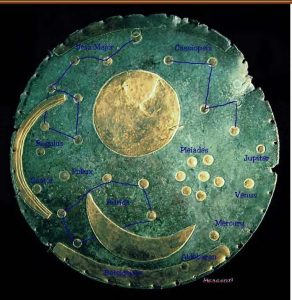Mel Copeland
Nebra Sky Disk (NSD) *
 The Nebra Sky Disk (NSD) is a bronze disk about a foot in diameter and inlaid with gold astronomical symbols. “The disk, two bronze swords, two hatchets, a chisel, and fragments of spiral bracelets were discovered in 1999 by Henry Westphal and Mario Renner while they were treasure-hunting with a metal detector. Archaeological artefacts are the property of the state in Saxony-Anhalt. The hunters were operating without a license and knew their activity constituted looting and was illegal. They damaged the disk with their spade and destroyed parts of the site.” The original finders were eventually charged and received short prison sentences.(a)
The Nebra Sky Disk (NSD) is a bronze disk about a foot in diameter and inlaid with gold astronomical symbols. “The disk, two bronze swords, two hatchets, a chisel, and fragments of spiral bracelets were discovered in 1999 by Henry Westphal and Mario Renner while they were treasure-hunting with a metal detector. Archaeological artefacts are the property of the state in Saxony-Anhalt. The hunters were operating without a license and knew their activity constituted looting and was illegal. They damaged the disk with their spade and destroyed parts of the site.” The original finders were eventually charged and received short prison sentences.(a)
Initially, the date of the disk was generally accepted as being around 1600 BC, but by the start of the 21st century, this was losing support and was being brought forward by as much as 1000 years.
The reasoning behind this proposed dating revision is explained on The Archaeologist.org website “research published in 2020 by archaeologists from Goethe University Frankfurt and Ludwig Maximilian University of Munich casts doubt on this dating. After re-evaluating prior research and the circumstances of the disc’s discovery, the authors argue that the disc was likely not part of the cache of Bronze Age weapons, and therefore, cannot be dated with these artefacts. Instead, they assert that the disc should be evaluated as an individual find. The authors contend it bears hallmarks of an Iron Age item, and they place its origins instead in the first millennium BC. This younger age, they argue, would significantly change the sometimes far-reaching cultural and historical conclusions that have been attributed to the disc.”(p)
Andis Kaulins has also written an extensive 2004 paper(i) on the Nebra Sky Disk in which he concluded “that the Nebra Sky Disk records the solar eclipse of April 16, 1699, BC for posterity. This interpretation allows not only for a partial explanation of the Nebra Sky Disk but in fact, explains all of the elements found on the disk in an integrated astronomical context which abides by the rules of the burden of proof. This interpretation fulfills the requirements of the preponderance of the evidence. The prevailing balance of probabilities is clearly in favor of our interpretation as opposed to the partial interpretation which has thus far been advanced.” Kaulins returned to the subject two years later with strong criticism of other intrepretations on offer, particularly a decipherment proposed by the State Museum for Prehistory at Halle(q).
A 2014 update(j) on the Disk was posted by Claudia Bracholdt. 2020 brought further debate with the claim, in a lengthy paper, that the date of the Disk should be brought forward to the 1st millennium BC(c). This was followed by a shorter but vehement rebuttal(k)(l). In 2020, researchers at Goethe University have also advocated reducing the claimed age of the disk(a)(n).
The Danish independent researcher, Ove Von Spaeth, has a wide-ranging article on cultural references to the Pleiades including the Nebra Sky Disk(d). He also touches on the subject of Atlantis.
A further possible consequence of the Theran eruption(s) was proposed after the discovery of the Nebra Sky Disk(g), which was buried about 3,600 years ago. This is suggested to have resulted from the volcanic ash generated by the eruption blotting out the sun for up to 25 years. It is thought that the NSD had been used to synchronise the lunar and solar calendars(e) and when this was no longer possible the Disk was buried as some form of an offering. A contrary view is offered elsewhere on the Internet(f), as well as further controversy(h) led by Peter Schauer from the University of Regensburg.
A 2015 paper from Mel Copeland offers further background information as well as a review of some NSD theories(m).
“The Nebra Sky Disk was the centrepiece of the British Museum’s exhibition ‘The World of Stonehenge’, which runs from February to July 2022. Its inclusion helps to establish Stonehenge’s links to the greater world and demonstrates how Bronze Age Britain was a bustling, sophisticated society.
Nevertheless, the Disk continues to generate scholarly debate, particularly with regard to its date. “A paper published in 2020 by Dr. Pernicka and Dr. Meller offered a strong rebuttal to the case for the Iron Age made by Dr. Gebhard and Rüdiger Krause, a professor of prehistory and early European history at Goethe University Frankfurt. While some believe this should settle the argument, other archaeologists think the debate will, and should, continue.” (r)
The story of the Disk has also made it into literature – Dr Harald Meller and science writer Kai Michel have written two German bestsellers exploring its history and the world it was created in: The Nebra Sky Disk and Reach for the Stars.”(o)
(a) https://en.wikipedia.org/wiki/Nebra_sky_disk#Dating
(b) https://phys.org/news/2020-09-dating-nebra-sky-disk.html
(c) Wayback Machine (archive.org)
(d) Archive 3363 | (atlantipedia.ie)
(e) http://www.meglithic.co.uk/article.php?sid=2146413876
(f) Nebra Speculation | Society for Interdisciplinary Studies (archive.org)
(g) http://www.dw.de/bronze-age-sky-disc-deciphered/a-1915398-1
(h) http://news.bbc.co.uk/2/hi/science/nature/6722953.stm
(i) Wayback Machine (archive.org)
(o) Hope Soars Eternal: The Nebra Sky Disk – Byline Times
(p) https://www.thearchaeologist.org/blog/the-nebra-sky-disk-real-or-fake
(q) https://ancientworldblog.blogspot.com/2006/03/nebra-sky-disk-eclipse-erroneously.html
(r) A Bitter Archaeological Feud Over an Ancient Vision of the Cosmos – The New York Times (nytimes.com)
